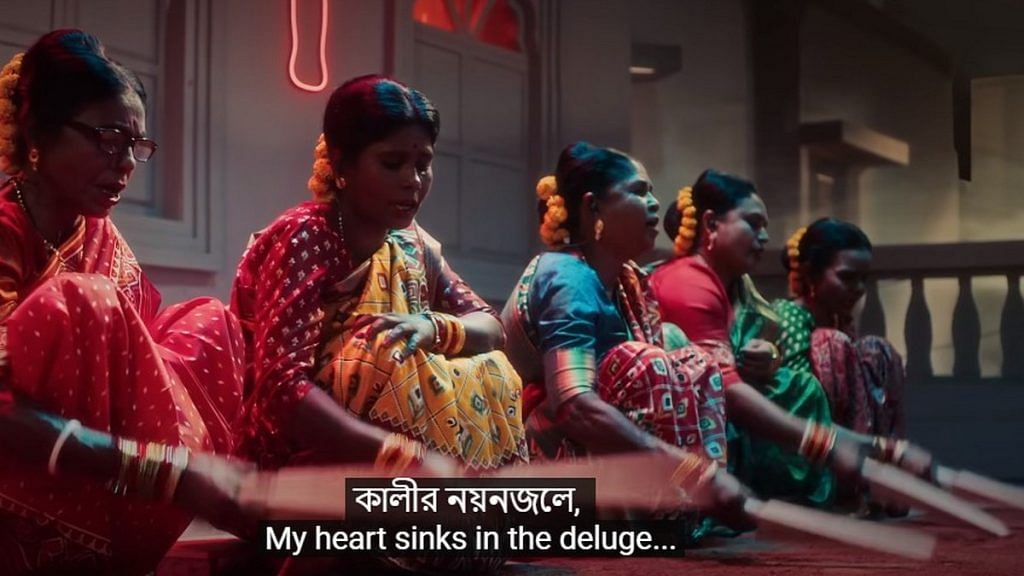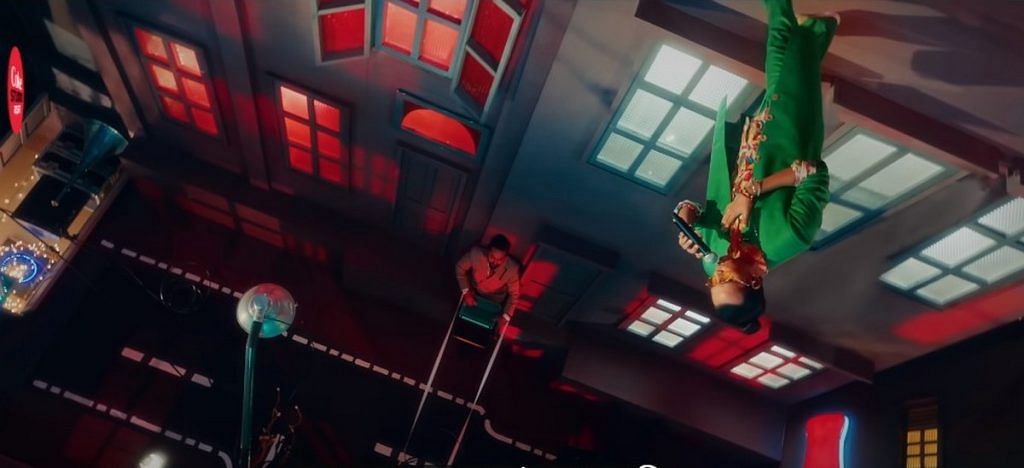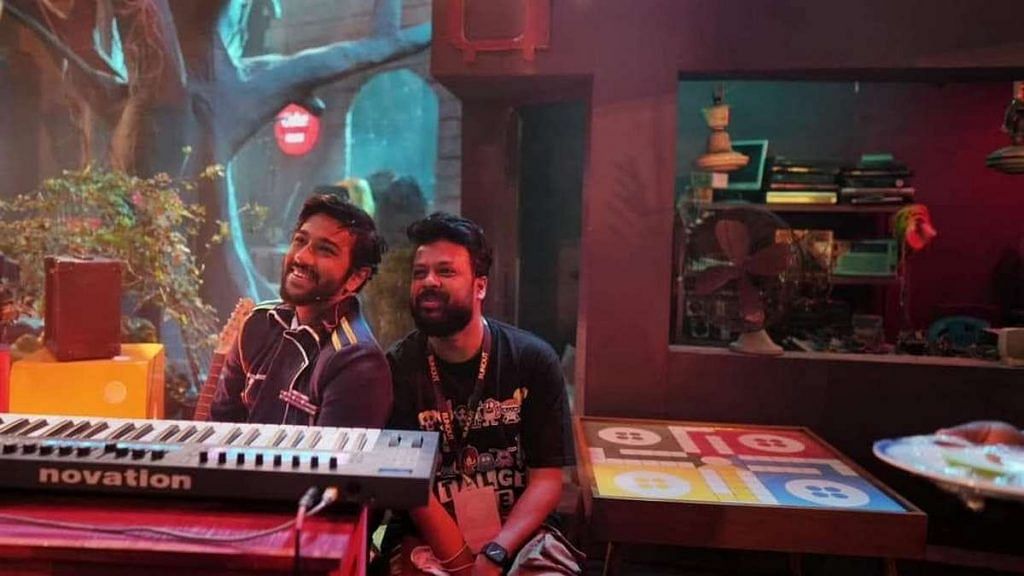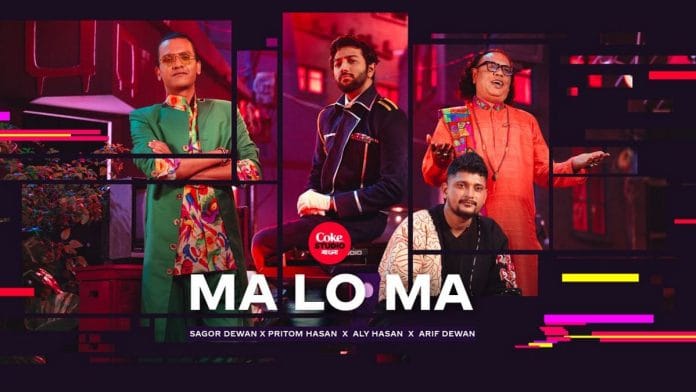Dhaka: A Bangladeshi anthem on maturing, mortality, and the mayhem of modern life, ‘Ma Lo Ma’ from Season 3 of Coke Studio Bangla has charmed audiences worldwide, racking up over 36 million views on YouTube since its release last month. Marrying folk, rap, and soul-stirring melody, it has everyone tapping their feet. ‘Ma Lo Ma’ is doing for Bangla music what ‘Naatu Naatu’ and ‘Jai Ho’ did for Indian film music, or what Diljit Dosanjh’s ‘G.O.A.T’ did for Bhangra.
Like the genre-bending nature of the song, which features strands of Hindu mythology adapted by Muslim musicians, the music video depicts a world turned upside down. Cities hang inverted from the skies, as a group of village women smoothen out the roof of a new building with paddles and sing a song of survival in a chaotic world.
The song has spawned a flurry of reaction videos from YouTubers around the world, each with thousands of views, from the US and Germany to Pakistan and South Africa. There’s also a surfeit of dance covers, including from the popular Norwegian troupe Quick Style and ‘Dancing Dad’ Ricky Pond. This doesn’t count the wave of Reels and Shorts set to the song, from Indian balconies to Italian streets to the pastoral Vogelberg in Switzerland.
Composed and produced by Bangladeshi singer, actor, and director Pritom Hasan, the song features evocative folk vocals by Sagor Dewan and Arif Dewan, and a rap interlude by Aly Hasan. It’s a reimagined traditional song, brought back as an answer to the existential crisis of our times, and rearranged to appeal both to traditional and modern musical tastes.
“Ma Lo Ma is a democratic coalition of different strands of music, like sari gaan from the Mughal period to chaad petano gaan, a musical tradition in our villages, and modern-day rap which appeals to our urban listeners,” said composer Pritom Hasan, speaking to ThePrint over the phone from Dhaka. “The right blend of sight and sound has contributed to the global success of Ma Lo Ma.”
But it is the underlying message of the song that seems to have touched a chord with those who follow the language and can navigate through the sea of metaphors in Ma Lo Ma’s lyrics.
“That message is one of hope in a world gone topsy turvy. What the world is celebrating today is the power of the local. Local tales and local music put out with innocence and honesty will win the world over, just like Diljit Dosanjh has done with Punjabi music,” said Hasan.
What the song also speaks to is the composite culture of Bangladesh, where Hindu myths sit comfortably in songs sung by Muslim musicians.
Also Read: History, heritage, hustle—Bengali filmmaker Prataya Saha’s 5-min movies on big cities go global
Myths, metaphors, and modern life
‘Ma Lo Ma’ starts with a reference to a broken boat and then quickly segues to lyrics referencing the Hindu mythological tale of the snake goddess Manasa and the venomous wrath she unleashes on a newlywed couple.
The story goes that Manasa, a subaltern goddess worshipped in eastern India and Bangladesh, desired a seat among the higher goddesses. To achieve this, she sought ‘anjali’ (a divine offering) from Chand Sadagar, a devout Shiva-bhakt. When denied, Manasa exacted revenge by sending her most poisonous snake to bite Chand Sadagar’s son Lokhindar on the night he weds a woman called Behula.
“Kali noyonjole/jole buk bheshe jay/ki saap e kamrailo amar/durlov Lokai-er gay (Tears from Kali’s eyes deluge the soul/ What serpent has bitten my beloved Lokai lifeless),” chorus a group of women, with Behula’s imagined words.

But Behula doesn’t dissolve in a puddle of tears. Instead, she takes her dead husband on a raft toward the heavens, braving great dangers on the way. Upon reaching, she impresses the gods with her story and dance, ultimately bringing Lokhindar back to life.
Ma Lo Ma draws on this subaltern Hindu myth to convey hope and resilience in a chaotic world. Apart from the refrain by the women singers, this portion is sung by Arif Dewan and Shagor Dewan in a Bengali folk style called ‘chaad petano gaan’, which roughly translates to ‘song sung while flattening a roof’, and which is said to match the rhythm of such a task. What the song also speaks to is the composite culture of Bangladesh, where Hindu myths sit comfortably in songs sung by Muslim musicians.
Look how successfully Diljit Dosanjh has taken Punjabi music to the world. If we could bring the music and stories of Bangladesh and West Bengal together and work as a team, we can conquer the world too
-Pritom Hasan, composer
Since season one of Coke Studio Bangla, curator and producer, singer-songwriter Shayan Chowdhury Arnob, has unearthed various grassroots musical styles, from riverine Bhatiali folk songs and plaintive Bhawaiya odes, pairing them with contemporary genres like Rabindra Sangeet and ghazals, with a sprinkling of modern rock and rap. But Ma Lo Ma has resonated the most.
For Bangladeshi actor Rafiath Rashid Mithila, a keen follower of Coke Studio Bangla, what makes the song so effective, through the story of Behula, is its core message about “adulting” in an often-harsh world.
“Adulting is an existential crisis felt across the world. And yet, like Behula, we should all carry on. The world of ‘Ma Lo Ma’, like ours, is chaotic and problem ridden. And yet, women and men dance and go about their daily chores, signalling to us the need to hold on no matter what the difficulties are, with a smile on the face and a song on the lips,” Mithila said. “The beauty of that message and the coming together of so many disparate musical strands has made Ma Lo Ma a global rage.”

The visuals reinforce this message. For the music video, director Adnan Al Rajeev created an inverted world to show disorder and confusion.
“This crazy architecture depicted the perseverance and tenacity of those who survive amidst the congestion and unplanned set up, for real. We had puppets on set, played by actors, to show how the deprived are controlled by the powerful in these chaotic cities,” Rajeev told the Bangladeshi newspaper Daily Star, adding that this also mirrored the experiences of economic migrants who flock to big cities in search of better lives.
Another metaphor that keeps popping up in the music video is that of a boat making its way down a river—an allusion to both Behula’s journey and that of everybody else.
‘If you know how to row it right, even a broken boat can sail,” the lyrics say at one point.
Hasan said he took a conscious decision to ensure that ‘Ma Lo Ma’ was not influenced by any non-Bangla linguistic or musical elements, despite some international stylistic components.
Also Read: OTT Chorki shook Bangladesh and West Bengal with its taboo stories. It has big India plans
‘Big win for Bangla language’
‘Ma Lo Ma’ is Bangla through and through, from language to cultural references. And to composer Pritom Hasan, its global success as is a nod to the power of the local.
Hasan said he took a conscious decision to ensure that ‘Ma Lo Ma’ was not influenced by any non-Bangla linguistic or musical elements, even if there are some international stylistic components.

“By Bengal, I mean both Bangladesh and West Bengal. We have taken greats pains to stitch together various strands of Bangla music, but we did not want to be influenced by either Bollywood or Urdu or Punjabi,” he said.
Hasan is quick to clarify that as an artist, he is not opposed to syncretism in music, but advocates for maintaining fidelity to a local flavour.
“We should not let our original culture get diluted,” he said. “Look how successfully Diljit Dosanjh has taken Punjabi music to the world and has become a global superstar. If we could bring the music and stories of Bangladesh and West Bengal together and work as a team, we can conquer the world too. ‘Ma Lo Ma’ is proof.”
Across the border, in West Bengal, ‘Ma Lo Ma’ is being heard and discussed ad nauseam.
Kolkata-based filmmaker Prasun Chatterjee told ThePrint that he was not enamoured of the visuals, but the song itself has an X factor that has appealed to a global audience.
“The way Bangladeshi musicians have used indigenous gharanas is a lesson for musicians and directors of West Bengal. We need to dig deeper into our roots,” he said. “It is not about West Bengal or Bangladesh, but the Bangla language itself. ‘Ma Lo Ma’ is a big win for the Bangla language.”
(Edited by Asavari Singh)






